Measuring Key Quality Indicators in Cloud Gaming: Framework and Assessment Over Wireless Networks
Abstract
1. Introduction
2. Cloud Gaming Overview
2.1. Online and Cloud Gaming Comparison
2.2. Cloud Gaming Platforms
2.3. Cloud Gaming QoE
3. Proposed System
3.1. Framework Architecture
3.2. Actions Automation Tool
- Coordinates calibration: This function configures JSON files that are used for determining X and Y coordinates, for each mouse action simulation during a session. This data is calibrated for several video resolutions in a previous phase before the tests.
- Client configuration: This phase is dedicated to set up the session parameters, such as resolution, frame rate, audio mode, coder, and decoder. These elements are configured before a group of tests are launched for the testbed.
- Moonlight client control: After the configuration procedure, this block allows the execution, creation, and finalization of a Cloud Gaming session using Moonlight stream client. This function uses actions emulation in the thin client.
- In-game actions control: Once the game session is ready, this function emulates the keyboard and mouse actions that are used for simulating the user interaction with game logic. These actions are generated in the thin client, but they are also captured and transported to the server.
- Metrics extraction: Finally, this feature permits to manage and launch the metrics extraction tool once the game simulation is finished.
3.3. KQIs Extraction Tool
4. Evaluation and Discussion
4.1. Setup
4.2. Inter-Technology Comparison
4.3. KQIs and Configuration Parameters Relationships
5. Conclusions & Outlook
Author Contributions
Funding
Institutional Review Board Statement
Informed Consent Statement
Data Availability Statement
Acknowledgments
Conflicts of Interest
References
- Wiljman, T. Newzoo Global Games Market Report 2019. Available online: https://newzoo.com/insights/trend-reports/newzoo-global-games-market-report-2019-light-version/ (accessed on 7 October 2020).
- Hart, C.B. The evolution and social impact of video game economics. Inf. Soc. 2017, 166. [Google Scholar] [CrossRef]
- Metzger, S.A.; Paxton, R.J. Gaming History: A Framework for What Video Games Teach About the Past. Theory Res. Soc. Educ. 2016, 44, 532–564. [Google Scholar] [CrossRef]
- Lattin, C.; Martin, A.G.; Sirigampola, S.; Zielinksy, S. Computational and Network Utilization in the Application of Thin Clients in Cloud-Based Virtual Applications. In HCI International 2019—Posters, 2019th ed.; Stephanidis, C., Ed.; Springer: Cham, Switzerland, 2019; p. 7. [Google Scholar]
- Laghari, A.A.; He, H.; Memon, K.A.; Laghari, R.A.; Halepoto, I.A.; Khan, A. Quality of experience (QoE) in cloud gaming models: A review. Multiagent Grid Syst. 2019, 15, 289–304. [Google Scholar] [CrossRef]
- Popović, M.; Drajić, D.; Svoboda, P.; Nikaein, N.; Krčo, S.; Laner, M. Latency analysis for M2M and Online Gaming traffic in an HSPA network. Ad Hoc Sens. Wirel. Netw. 2016, 31, 259–277. [Google Scholar]
- Hong, H.J.; Hsu, C.F.; Tsai, T.H.; Huang, C.Y.; Chen, K.T.; Hsu, C.H. Enabling Adaptive Cloud Gaming in an Open-Source Cloud Gaming Platform. IEEE Trans. Circuits Syst. Video Technol. 2015, 25, 2078–2091. [Google Scholar] [CrossRef]
- Beyer, J.; Varbelow, R. Stream-A-Game: An open-source mobile Cloud Gaming platform. In Proceedings of the Annual Workshop on Network and Systems Support for Games, Zagreb, Croatia, 3–4 December 2015; IEEE Computer Society: Washington, DC, USA, 2016; Volume 2016-January. [Google Scholar] [CrossRef]
- Slivar, I.; Sužnjević, M.; Skorin-Kapov, L.; Ilić, V. Cloud gaming in education: Evaluation of multiple game streams in a shared WLAN. In Proceedings of the2016 Zooming Innovation in Consumer Electronics International Conference, ZINC 2016, Novi Sad, Serbia, 1–2 June 2016; pp. 62–65. [Google Scholar] [CrossRef]
- Wu, R. Towards cloudlet-based mobile cloud gaming. In Proceedings of the PIC 2016—Proceedings of the 2016 IEEE International Conference on Progress in Informatics and Computing, Shanghai, China, 23–25 December 2016; Institute of Electrical and Electronics Engineers Inc.: New York, NY, USA, 2017; pp. 492–497. [Google Scholar] [CrossRef]
- Lin, Y.; Shen, H. Leveraging Fog to Extend Cloud Gaming for Thin-Client MMOG with High Quality of Experience. In Proceedings of the International Conference on Distributed Computing Systems, Columbus, OH, USA, 29 June–2 July 2015; Institute of Electrical and Electronics Engineers Inc.: New York, NY, USA, 2015; Volume 2015-July, pp. 734–735. [Google Scholar] [CrossRef]
- Lin, Y.; Shen, H. Cloud fog: Towards high quality of experience in cloud gaming. In Proceedings of the International Conference on Parallel Processing, Beijing, China, 1–4 September 2015; Institute of Electrical and Electronics Engineers Inc.: New York, NY, USA, 2015; Volume 2015-December, pp. 500–509. [Google Scholar] [CrossRef]
- Sabet, S.S.; Schmidt, S.; Zadtootaghaj, S.; Griwodz, C.; Moller, S. Towards the Impact of Gamers Strategy and User Inputs on the Delay Sensitivity of Cloud Games. In Proceedings of the 2020 12th International Conference on Quality of Multimedia Experience (QoMEX 2020), Athlone, Ireland, 26–28 May 2020; Institute of Electrical and Electronics Engineers Inc.: New York, NY, USA, 2020. [Google Scholar] [CrossRef]
- Semsarzadeh, M.; Yassine, A.; Shirmohammadi, S. Video Encoding Acceleration in Cloud Gaming. IEEE Trans. Circuits Syst. Video Technol. 2015, 25, 1975–1987. [Google Scholar] [CrossRef]
- Ahmadi, H.; Khoshnood, S.; Hashemi, M.R.; Shirmohammadi, S. Efficient bitrate reduction using a game attention model in cloud gaming. In Proceedings of the HAVE 2013—2013 IEEE International Symposium on Haptic Audio-Visual Environments and Games, Istanbul, Turkey, 26–27 October 2013; pp. 103–108. [Google Scholar] [CrossRef]
- Babaei, E.; Hashemi, M.R.; Shirmohammadi, S. A state-based game attention model for cloud gaming. In Proceedings of the Annual Workshop on Network and Systems Support for Games, Taipei, Taiwan, 22–23 June 2017; IEEE Computer Society: Washington, DC, USA, 2017; pp. 34–36. [Google Scholar] [CrossRef]
- Wang, R.; Xue, M.; Chen, K.; Li, Z.; Dong, T.; Sun, Y. BMA: Bandwidth allocation management for distributed systems under cloud gaming. In Proceedings of the 2015 IEEE International Conference on Communication Software and Networks (ICCSN 2015), Chengdu, China, 6–7 June 2015; Institute of Electrical and Electronics Engineers Inc.: New York, NY, USA, 2015; pp. 414–418. [Google Scholar] [CrossRef]
- Seyed Aboutorabi, S.J.; Rezvani, M.H. A Self-organizing Price-based Mechanism for Frame Rate Optimization in Cloud Gaming Networks Considering Quality of Experience. In Proceedings of the 2018 2nd National and 1st International Digital Games Research Conference: Trends, Technologies, and Applications (DGRC 2018), Tehran, Iran, 29–30 November 2018; Institute of Electrical and Electronics Engineers Inc.: New York, NY, USA, 2018; pp. 51–60. [Google Scholar] [CrossRef]
- The Open Group and TeleManagement Forum. “SLA Management Handbook Volume 4 Enterprise Perspective”; The Open Group: Reading, UK, 2004. [Google Scholar]
- Herrera-Garcia, A.; Fortes, S.; Baena Martinez, E.; Mendoza, J.; Baena, C.; Barco, R. End-To-End Network Management: Modeling Key Quality Indicators. IEEE Veh. Technol. Mag. 2019, 14, 76–84. [Google Scholar] [CrossRef]
- Fortes, S.; Santoyo-Ramón, J.A.; Palacios, D.; Baena, E.; Mora-García, R.; Medina, M.; Mora, P.; Barco, R. The Campus as a Smart City: University of Málaga Environmental, Learning, and Research Approaches. Sensors 2019, 19, 1349. [Google Scholar] [CrossRef] [PubMed]
- Baena, C.; Fortes, S.; Baena, E.; Barco, R. Estimation of Video Streaming KQIs for Radio Access Negotiation in Network Slicing Scenarios. IEEE Commun. Lett. 2020, 24, 1304–1307. [Google Scholar] [CrossRef]
- Vaser, M.; Forconi, S. QoS KPI and QoE KQI Relationship for LTE VIdeo Streaming and VoLTE Services. In Proceedings of the NGMAST 2015: The 9th International Conference on Next Generation Mobile Applications, Services and Technologies, Cambridge, UK, 9–11 September 2015; Institute of Electrical and Electronics Engineers Inc.: New York, NY, USA, 2016; pp. 318–323. [Google Scholar] [CrossRef]
- Krogfoss, B.; Duran, J.; Perez, P.; Bouwen, J. Quantifying the Value of 5G and Edge Cloud on QoE for AR/VR. In Proceedings of the 2020 12th International Conference on Quality of Multimedia Experience (QoMEX 2020), Athlone, Ireland, 26–28 May 2020; Institute of Electrical and Electronics Engineers Inc.: New York, NY, USA, 2020. [Google Scholar] [CrossRef]
- Huang, C.Y.; Hsu, C.H.; Chang, Y.C.; Chen, K.T. GamingAnywhere: An open cloud gaming system. In Proceedings of the 4th ACM Multimedia Systems Conference (MMSys), Oslo, Norway, 28 February–1 March 2013; pp. 36–47. [Google Scholar] [CrossRef]
- Shea, R.; Liu, J.; Ngai, E.C.; Cui, Y. Cloud gaming: Architecture and performance. IEEE Netw. 2013, 27, 16–21. [Google Scholar] [CrossRef]
- Chuah, S.; Yuen, C.; Cheung, N. Cloud gaming: A green solution to massive multiplayer online games. IEEE Wirel. Commun. 2014, 21, 78–87. [Google Scholar] [CrossRef]
- Stadia FAQ—Stadia Official Support Website. Available online: https://support.google.com/stadia/answer/9338946?hl=en (accessed on 29 November 2020).
- NVIDIA GeForce NOW—GeForce Cloud Games. Available online: https://www.nvidia.com/es-es/geforce-now/ (accessed on 29 November 2020).
- GamingAnywhere: An Open Cloud Gaming System. Available online: http://gaminganywhere.org/ (accessed on 28 September 2020).
- Rainway. Game Streaming—Play Anywhere|Rainway. Available online: https://rainway.com/ (accessed on 30 November 2020).
- Moonlight-Stream. Moonlight Game Streaming: Play Your PC Games Remotely. Available online: https://moonlight-stream.org/ (accessed on 30 November 2020).
- Moonlight-Stream Discord Channel. Available online: https://moonlight-stream.org/discord (accessed on 2 January 2021).
- 3GPP. Study on Key Quality Indicators (KQIs) for Service Experience; TS 32.862; 3rd Generation Partnership Project (3GPP): Sophia Antipolis, France, 2016. [Google Scholar]
- Moller, S.; Schmidt, S.; Zadtootaghaj, S. New ITU-T Standards for Gaming QoE Evaluation and Management. In Proceedings of the 2018 10th International Conference on Quality of Multimedia Experience (QoMEX 2018), Cagliari, Italy, 29 May–1 June 2018. [Google Scholar] [CrossRef]
- Vlahovic, S.; Suznjevic, M.; Skorin-Kapov, L. The impact of network latency on gaming QoE for an FPS VR game. In Proceedings of the 2019 11th International Conference on Quality of Multimedia Experience (QoMEX 2019), Berlin, Germany, 5–7 June 2019; pp. 1–3. [Google Scholar] [CrossRef]
- Vlahovic, S.; Suznjevic, M.; Skorin-Kapov, L. Challenges in assessing network latency impact on QoE and in-game performance in VR first person shooter games. In Proceedings of the ConTEL 2019—15th International Conference on Telecommunications, Graz, Austria, 3–5 July 2019; pp. 1–8. [Google Scholar] [CrossRef]
- Claypool, M.; Claypool, K. Latency and Player actions in online games. Commun. ACM 2006, 49, 40–45. [Google Scholar] [CrossRef]
- Beigbeder, T.; Coughlan, R.; Lusher, C.; Plunkett, J.; Agu, E.; Claypool, M. The effects of loss and latency on user performance in unreal tournament 2003®. In Proceedings of the ACM SIGCOMM Workshop on Network and System Support for Games (NetGames’04), Portland, OR, USA, 30 August–3 September 2004; pp. 144–151. [Google Scholar] [CrossRef]
- Zadtootaghaj, S.; Schmidt, S.; Moller, S. Modeling Gaming QoE: Towards the Impact of Frame Rate and Bit Rate on Cloud Gaming. In Proceedings of the 2018 10th International Conference on Quality of Multimedia Experience (QoMEX 2018), Cagliari, Italy, 29 May–1 June 2018. [Google Scholar] [CrossRef]
- Slivar, I.; Skorin-Kapov, L.; Suznjevic, M. QoE-Aware Resource Allocation for Multiple Cloud Gaming Users Sharing a Bottleneck Link. In Proceedings of the 2019 22nd Conference on Innovation in Clouds, Internet and Networks and Workshops (ICIN 2019), Paris, France, 19–21 February 2019; pp. 118–123. [Google Scholar] [CrossRef]
- Europapress. Vodafone, premiada por su tecnología ‘CrowdCell’ que refuerza la cobertura 4G en interiores. Available online: https://www.europapress.es/economia/noticia-vodafone-premiada-tecnologia-crowdcell-refuerza-cobertura-4g-interiores-20170531190100.html (accessed on 9 October 2020).
- Rivet Networks. Killer Networking|Killernetworking|Killer Control Center. Available online: https://www.killernetworking.com/ (accessed on 22 October 2020).
- World Premiere: Amarisoft Launches the Amari LTE 100—Amarisoft. Available online: https://www.amarisoft.com/world-premiere-amarisoft-launches-the-amari-lte-100/ (accessed on 9 October 2020).
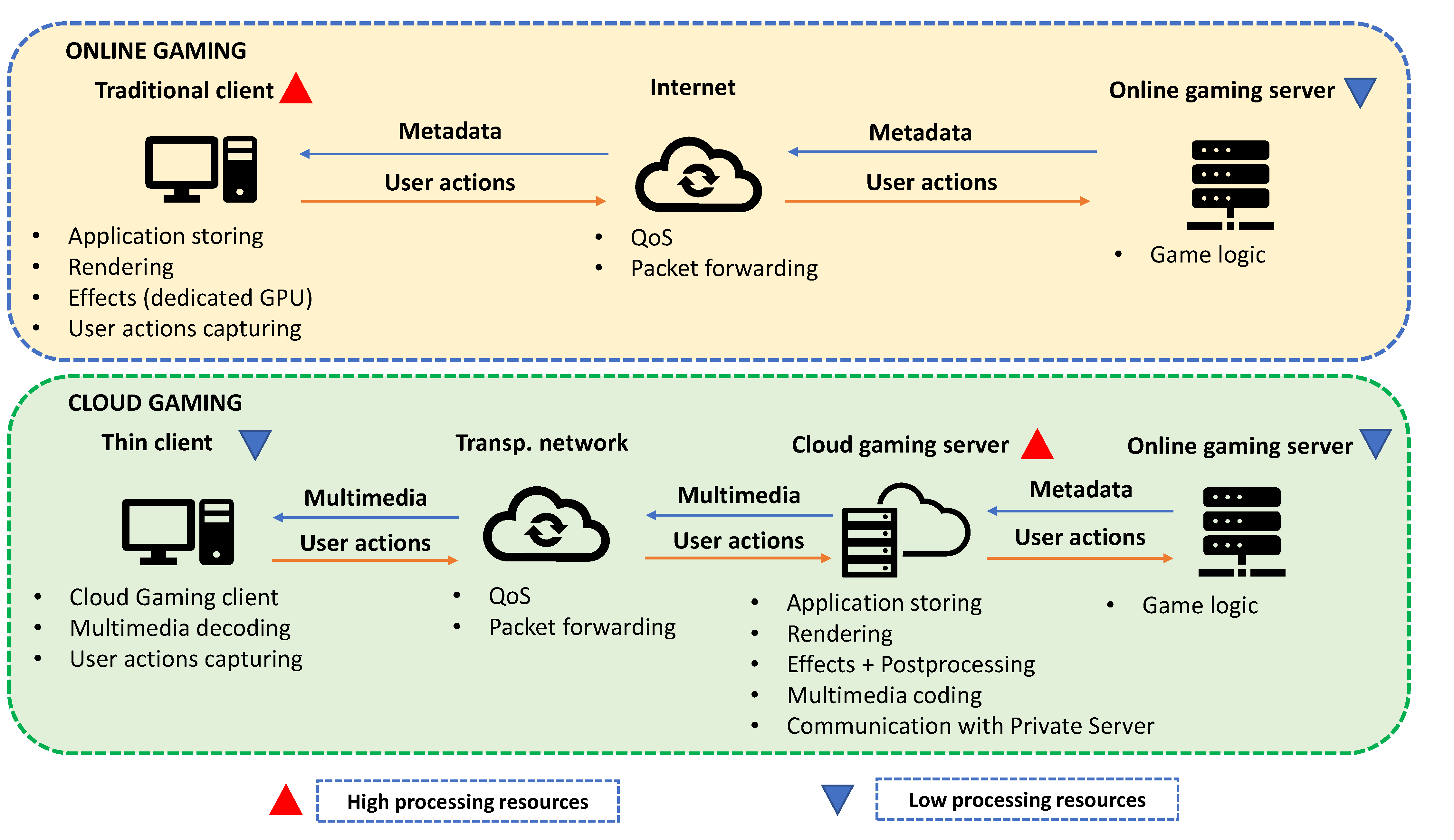


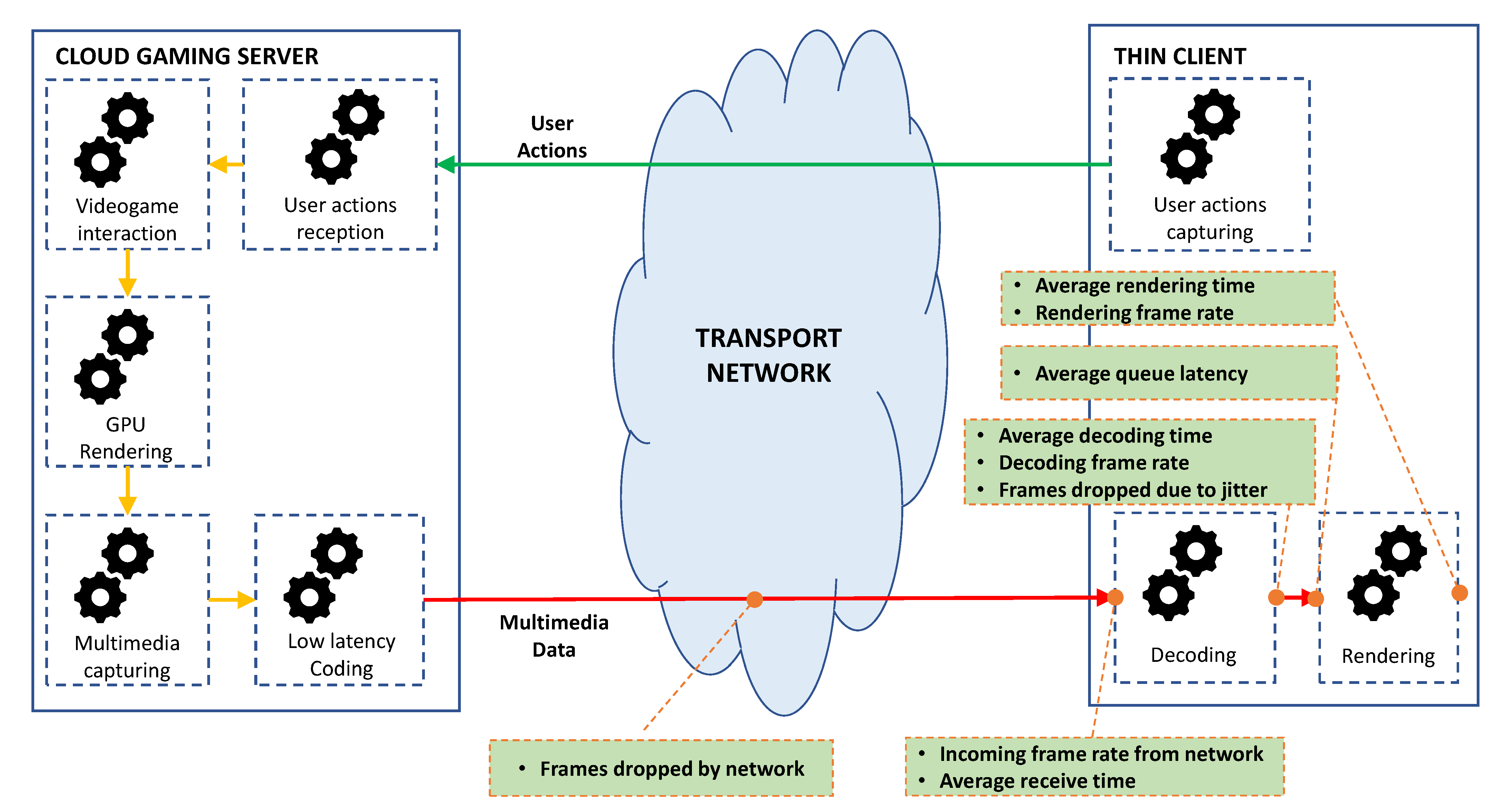
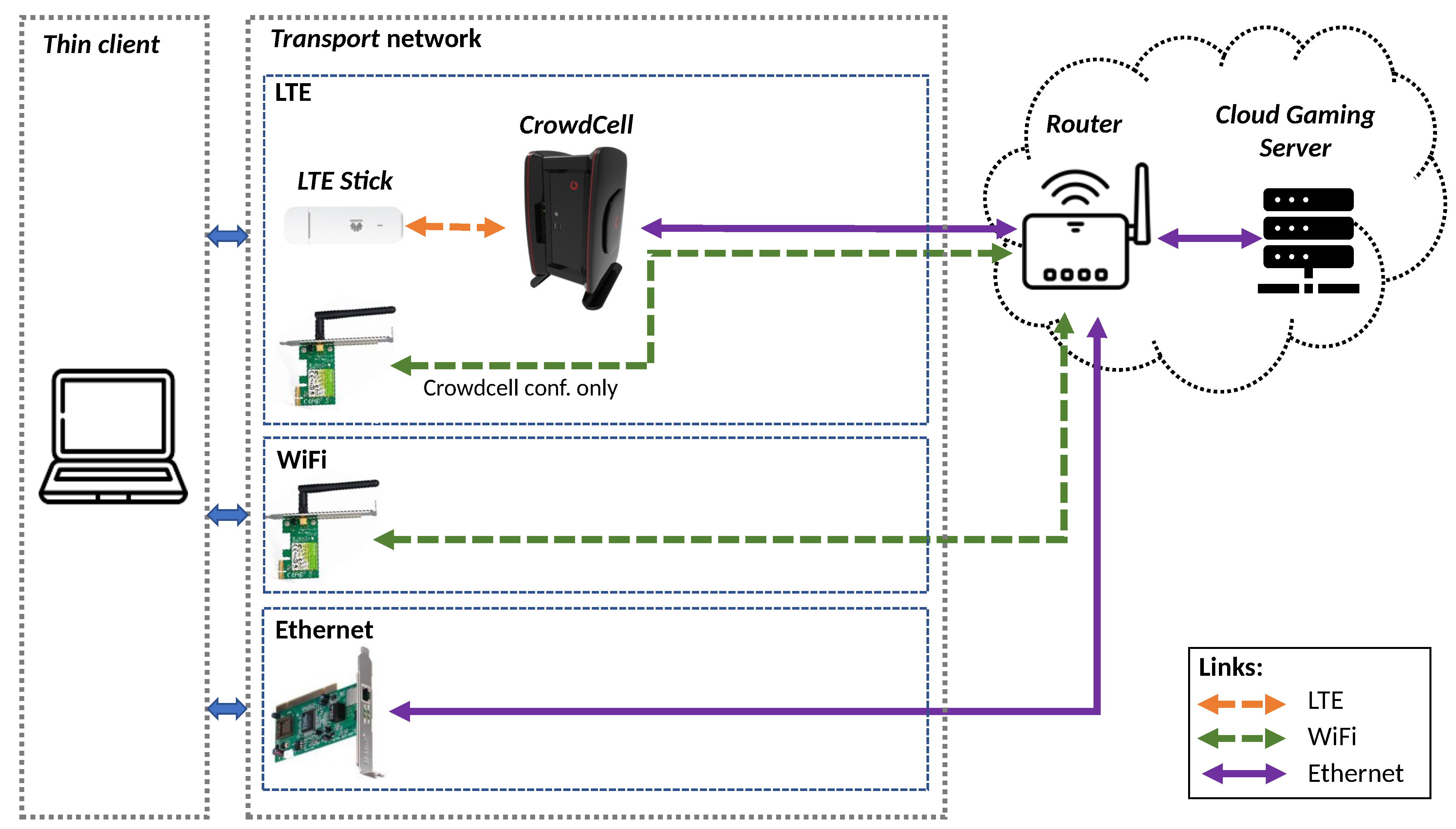

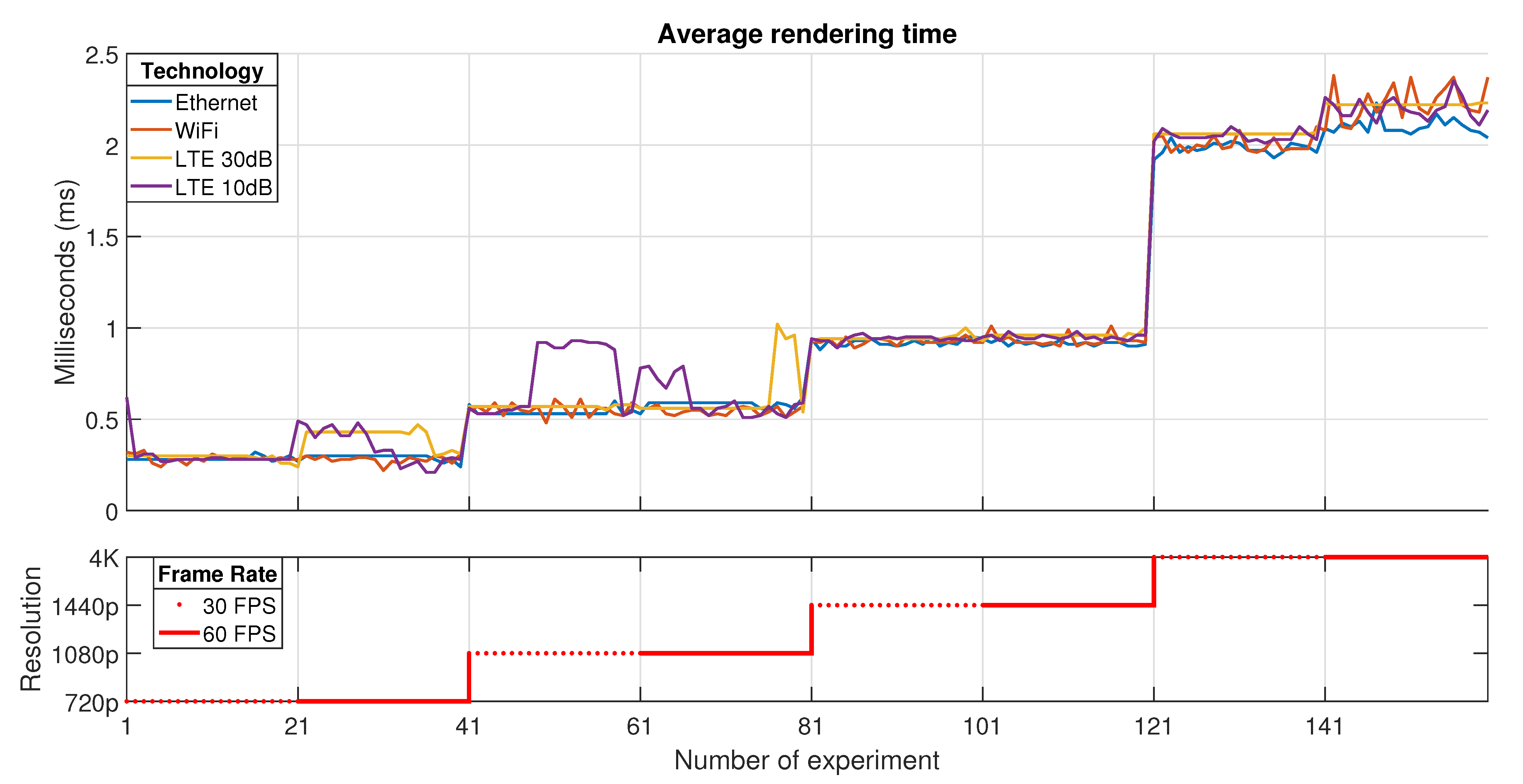
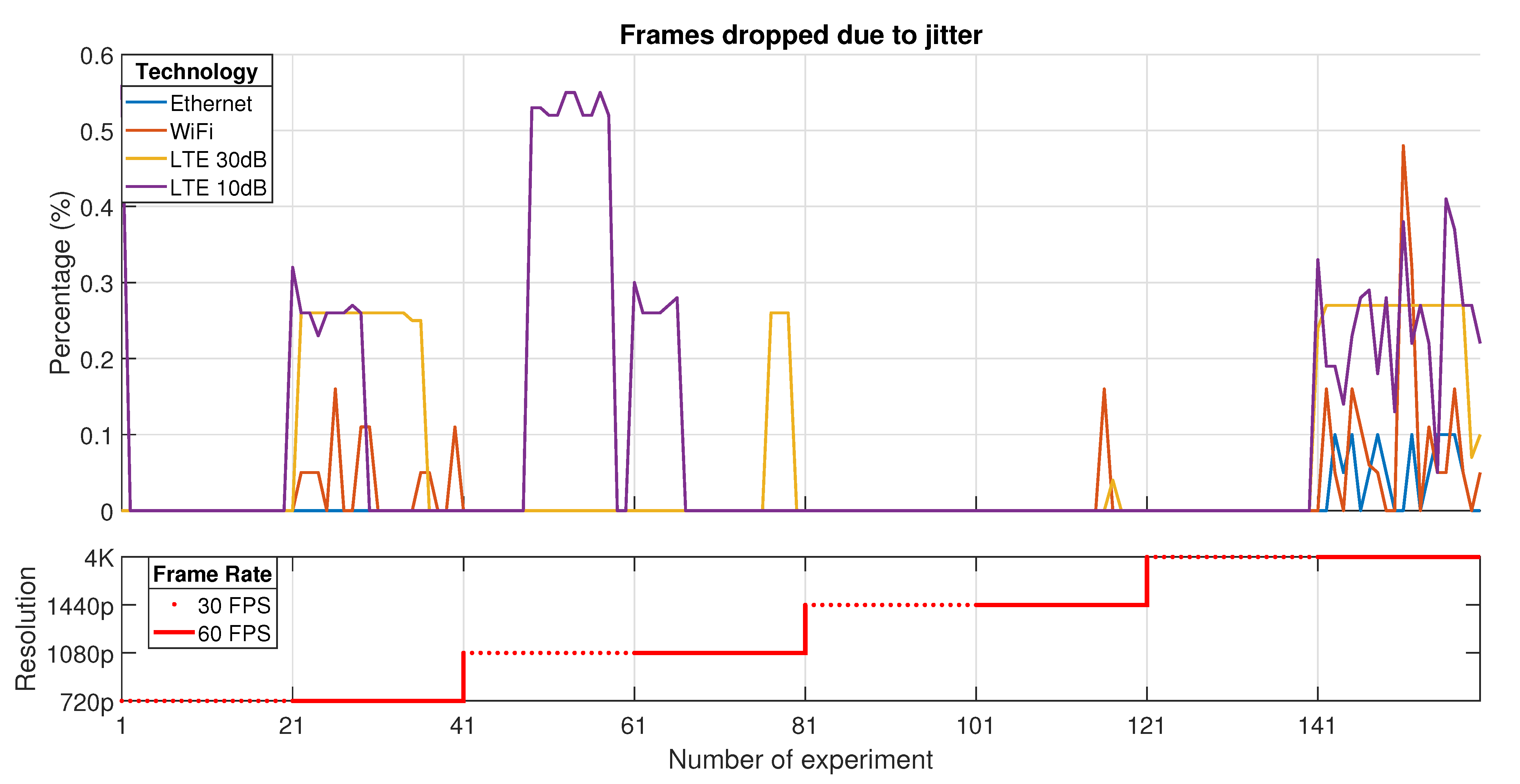

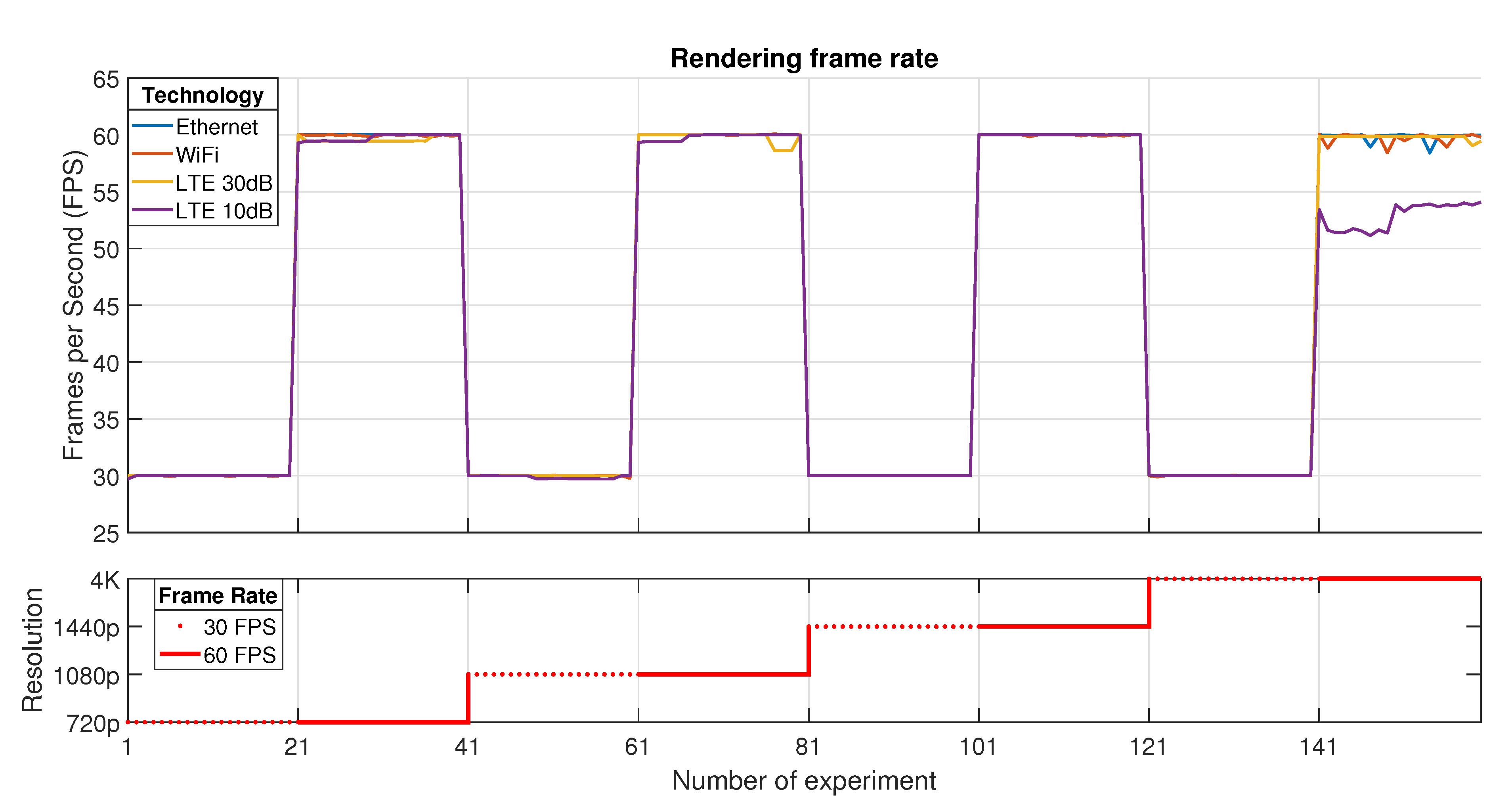
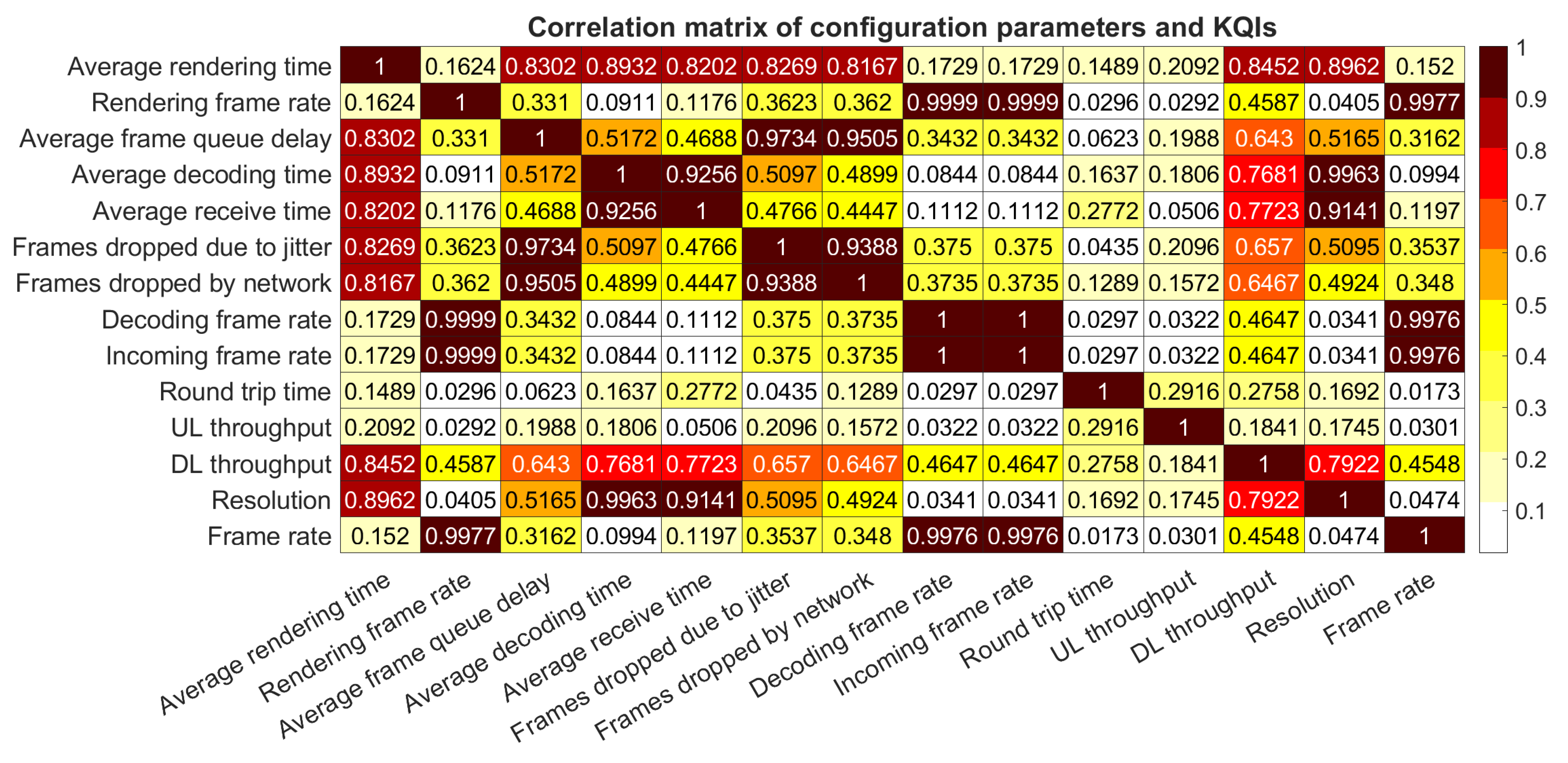
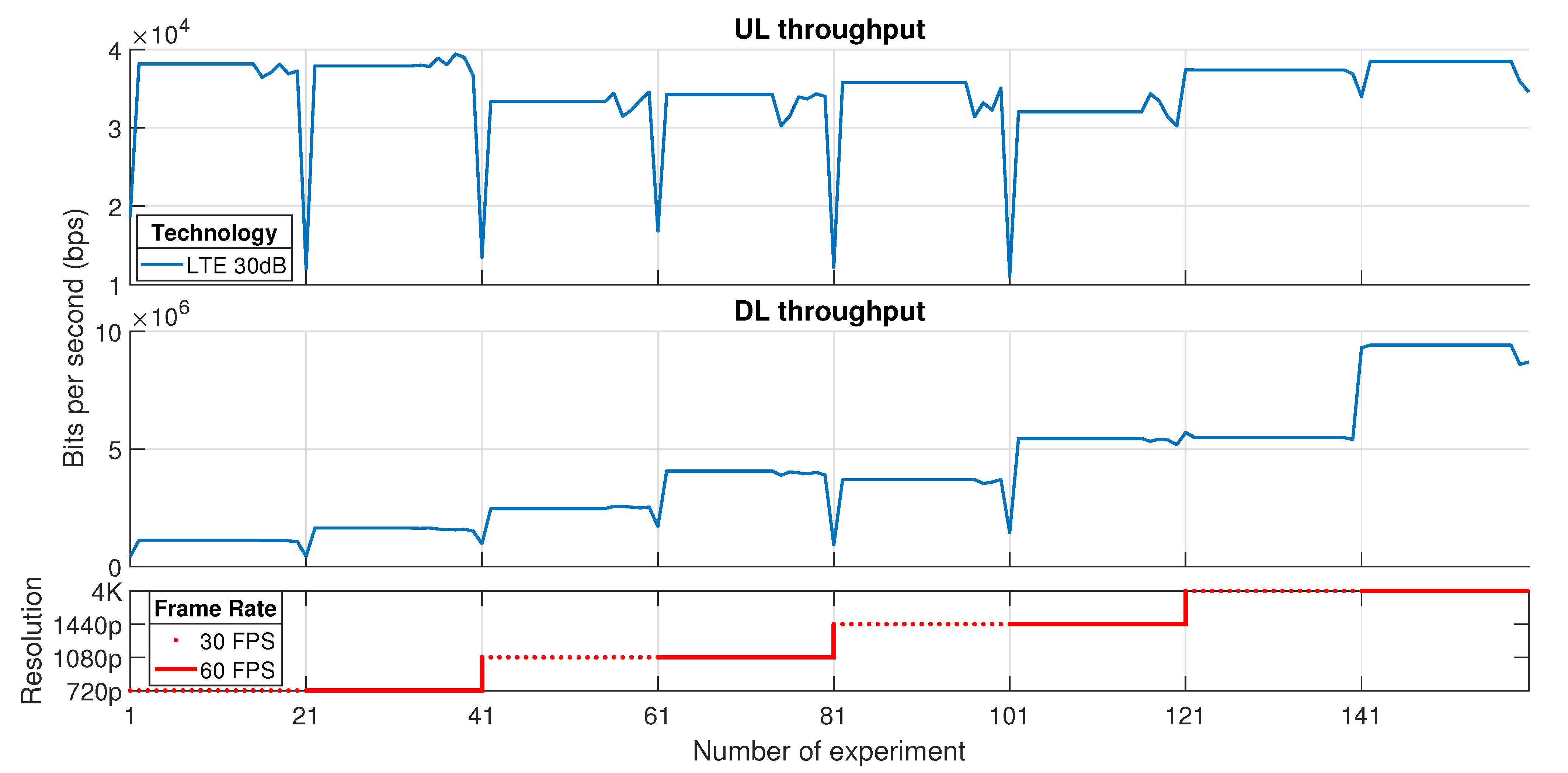
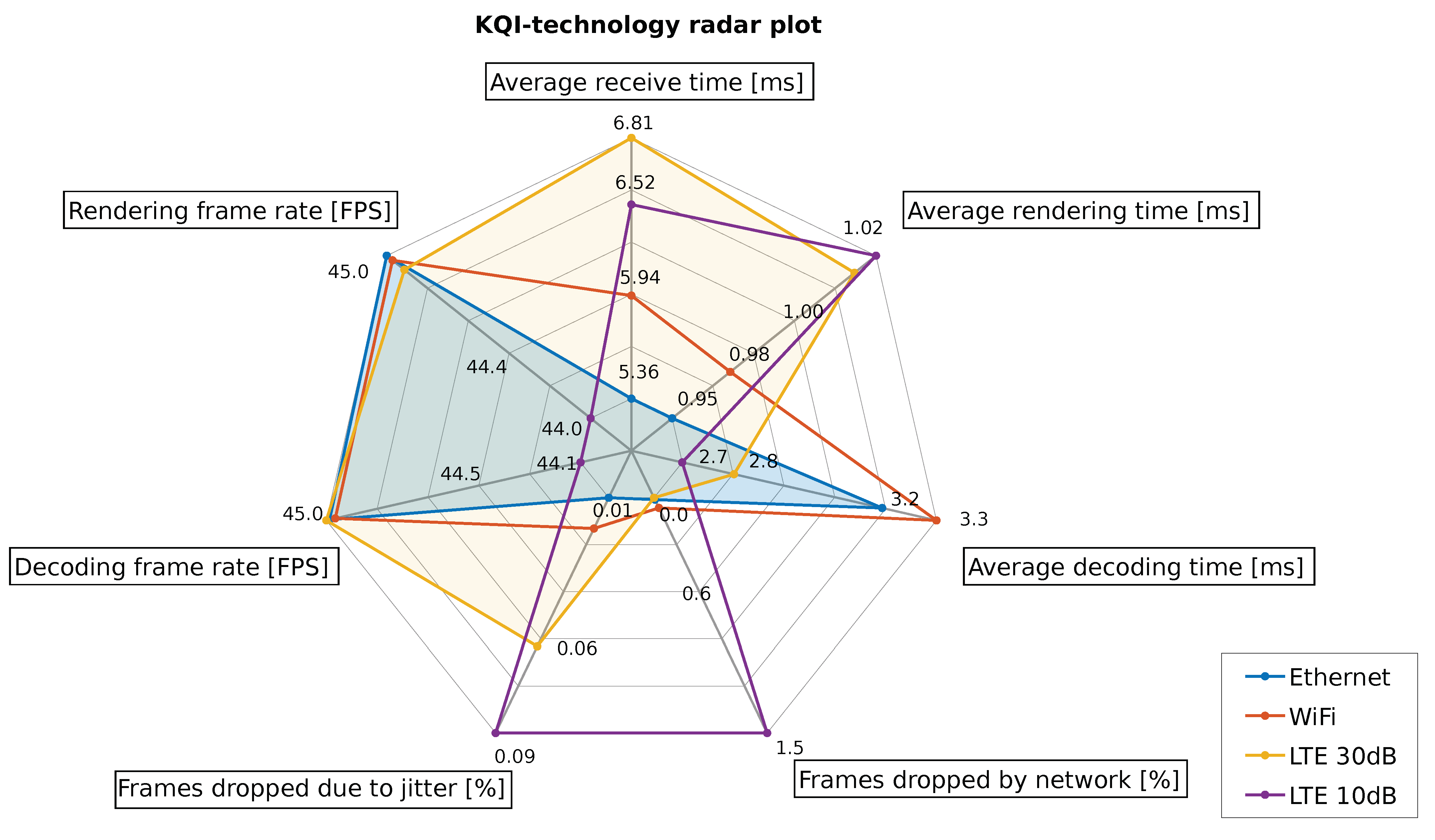
| Feature | Gaming Anywhere [30] | Rainway [31] | Moonlight [32] |
|---|---|---|---|
| Server-Client Architecture | Yes | Yes | Yes |
| Multimedia stream transport protocol | RTP | WebRTC | RTP |
| User actions transport protocol | TCP | WebRTC | UDP |
| Version control | Discontinued | GitHub | GitHub |
| Server host operating system | Linux | Windows | Windows |
| Graphics card requirement | O.S. Compatible | Agnostic | Nvidia GTX/RTX |
| Client host operating system | Multi-platform | Multi-platform | Multi-platform |
| Client configuration | Script | Interface | Interface |
| Game implementation | Manual | Search engine (MIST) | Search engine (Nvidia Experience) |
| Parameter | Description | Expected Value |
|---|---|---|
| Incoming frame rate from Network | Average estimated number of frames that are received in the thin client network interface. | Maximum as configured (30 or 60 FPS) |
| Decoding frame rate | Average number of decoded frames in the client. | Maximum as configured (30 or 60 FPS) |
| Rendering frame rate | Average number of rendered frames in the client. | Maximum as configured (30 or 60 FPS) |
| Frames dropped by network | Average percentage of lost frames in the transport process due to network errors or hardware limitations. | <15% |
| Frames dropped due to jitter | Average percentage of lost frames in the client buffer due to jitter. | <1% |
| Average receive time | Average time that an encoded frame needs to be completed since the first packet was sent from the server. The time estimation is just done among the non-discarded frames | <33.33 ms |
| Average decoding time | Average time that a reassembled frame needs to be decoded in the client. | <33.33 ms |
| Average rendering time | Average time that a decoded frame needs to be rendered and represented in client’s screen. This KQI consider V-SYNC latency. | <16.67 ms |
| Average frame queue delay | Average time that a decoded frame waits in the queue before the rendering process. | <16.67 ms |
| Parameter | Configuration |
|---|---|
| Resolution | 720p, 1080p, 1440p and 4k |
| Frames per second (FPS) | 30 FPS and 60 FPS |
| Audio mode | Stereo |
| Video decoding | Software |
| Video encoder | H.264 |
| Number of iterations per configuration | 20 |
| Ethernet bandwidth | 100 Mbps |
| WiFi Bandwidth channel | 20 MHz |
| LTE Bandwidth channel | 20 MHz |
| LTE Band | 7 |
| LTE Duplexation mode | FDD (Frequency Division Duplex) |
| LTE CrowdCell SNR (Signal-to-Noise Ratio) | 10 and 30 dB |
Publisher’s Note: MDPI stays neutral with regard to jurisdictional claims in published maps and institutional affiliations. |
© 2021 by the authors. Licensee MDPI, Basel, Switzerland. This article is an open access article distributed under the terms and conditions of the Creative Commons Attribution (CC BY) license (http://creativecommons.org/licenses/by/4.0/).
Share and Cite
Peñaherrera-Pulla, O.S.; Baena, C.; Fortes, S.; Baena, E.; Barco, R. Measuring Key Quality Indicators in Cloud Gaming: Framework and Assessment Over Wireless Networks. Sensors 2021, 21, 1387. https://doi.org/10.3390/s21041387
Peñaherrera-Pulla OS, Baena C, Fortes S, Baena E, Barco R. Measuring Key Quality Indicators in Cloud Gaming: Framework and Assessment Over Wireless Networks. Sensors. 2021; 21(4):1387. https://doi.org/10.3390/s21041387
Chicago/Turabian StylePeñaherrera-Pulla, Oswaldo Sebastian, Carlos Baena, Sergio Fortes, Eduardo Baena, and Raquel Barco. 2021. "Measuring Key Quality Indicators in Cloud Gaming: Framework and Assessment Over Wireless Networks" Sensors 21, no. 4: 1387. https://doi.org/10.3390/s21041387
APA StylePeñaherrera-Pulla, O. S., Baena, C., Fortes, S., Baena, E., & Barco, R. (2021). Measuring Key Quality Indicators in Cloud Gaming: Framework and Assessment Over Wireless Networks. Sensors, 21(4), 1387. https://doi.org/10.3390/s21041387









